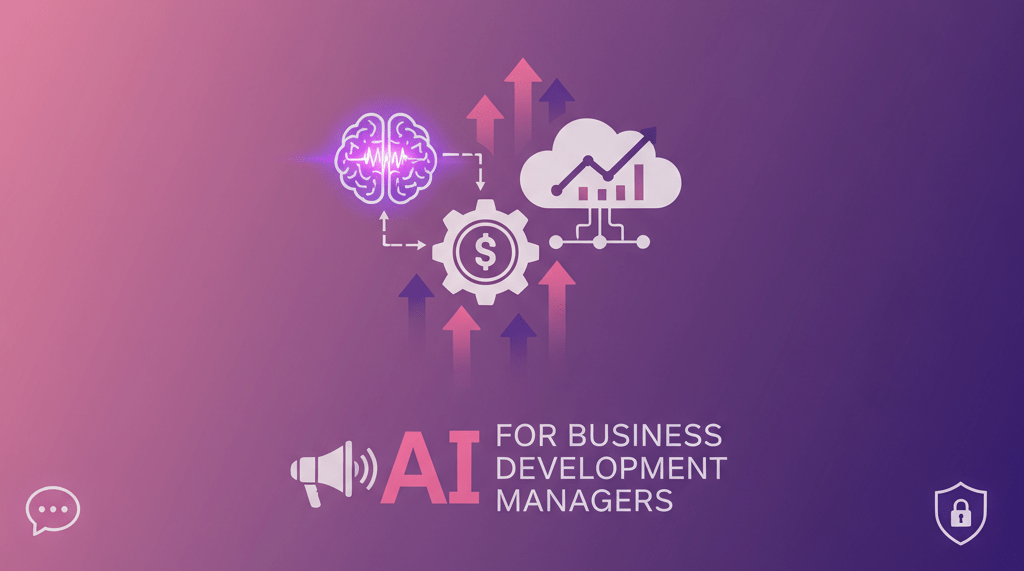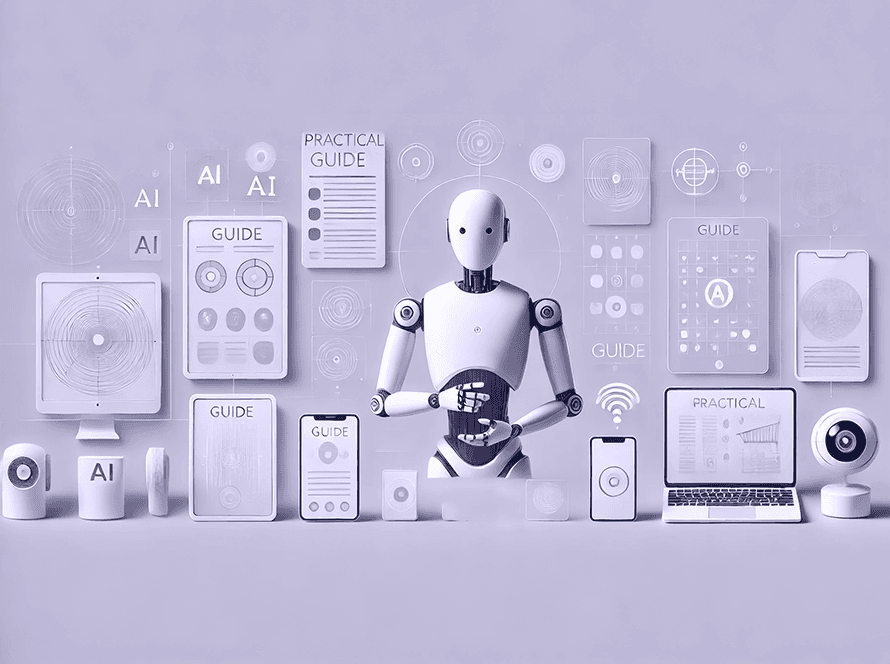“Empower AI for Business Development Managers to automate high-volume prospecting and qualification, freeing them to focus on strategic partnerships and complex deal closure.”
The business development landscape is shifting. For too long, Business Development Managers (BDMs) have been bogged down in the trenches, struggling through repetitive tasks that drain their time and energy. Cold calling, initial qualification, and high-volume outreach are essential, yes, but they don’t define the true strategic power of a BDM. It’s time for a change. It’s time for BDMs to step into their rightful place as high-level strategists.
This isn’t about replacing BDMs. It’s about empowering them. It’s about giving them the tools to delegate the grunt work. Imagine an AI as your tireless assistant, a digital voice that executes your strategy flawlessly. This article provides a playbook. It shows you how to design, script, and manage an AI-powered prospecting campaign. You become the strategic “brain,” and the AI becomes the reliable “voice.” We’ll then introduce SalesCloser.ai, a partner that makes this vision a reality.
By harnessing AI, you can refocus your efforts. Nurture key accounts. Forge strategic partnerships. Analyze market trends. Meanwhile, your AI builds a consistent, scalable, and predictable pipeline. This is the future of business development. Let’s dive in.
The BDM’s Dilemma: Drowning in the Day-to-Day
Think about your typical week. How much time do you spend on activities that truly move the needle? How much time goes into tasks that feel more like administrative duties?
Most BDMs face a similar challenge. They’re expected to identify new market opportunities. They need to build strategic alliances. They have to close significant deals. These are high-impact responsibilities. Yet, many spend a large chunk of their day on low-impact, high-volume activities.
Consider the traditional business development process. It often starts with extensive research. You identify potential leads. Then comes the outreach. This typically involves making hundreds of cold calls. It means countless emails. Each interaction requires initial qualification. You determine if a prospect is a good fit. You gauge their interest. This takes immense effort. It also requires a significant amount of time.
This constant churn prevents BDMs from focusing on higher-value work. They become reactive, not proactive. They chase leads instead of cultivating relationships. They execute tactics rather than crafting a strategy. This cycle is unsustainable. It leads to burnout. It limits growth. It’s time to break free.
The AI Advantage: Your Strategic Partner
Enter Artificial Intelligence. AI is not a magic bullet. It’s a powerful tool. When used correctly, it transforms the BDM role. It takes over the repetitive tasks. It frees you up for strategic thinking.
Think of AI as an extension of your team. It handles the initial heavy lifting. It works tirelessly. It never gets tired. It follows your instructions precisely. This means more consistent results. It means a more predictable pipeline.
What kind of tasks can AI handle? The list is extensive. AI can automate partnership outreach. It can manage strategic account prospecting. It can identify new market opportunities. It can even help with initial lead qualification. All these tasks are crucial. They are also time-consuming. Delegating them to AI significantly boosts BDM productivity.
This shift allows you to move from tactical execution to strategic oversight. You design the campaign. You set the parameters. You monitor the results. The AI executes the plan. You become the architect of your pipeline, not just another bricklayer.
Designing Your AI-Powered Prospecting Campaign: A Framework
Building an effective AI-powered prospecting campaign requires careful planning and execution. You can’t just unleash an AI and expect magic. You need a clear strategy. You need to define your goals. You need to provide the AI with the proper instructions. Here’s a framework to guide you.
Step 1: Define Your Ideal Customer Profile (ICP)
Before any outreach, know who you’re targeting. This is fundamental. Who are your best customers? What industries do they belong to? What are their company sizes? What challenges do they face?
Be specific. The more detailed your ICP, the better your AI can identify suitable prospects. For instance, don’t just say “tech companies.” Instead, specify “SaaS companies in the healthcare sector, with 50-200 employees, experiencing challenges with patient data management.” This level of detail ensures your AI targets accurately. This saves time and resources.
Your ICP guides the AI’s search parameters. It informs the messaging. It determines the success metrics. Take the time to get this right. It’s the foundation of your campaign.
Step 2: Craft Compelling Messaging and Scripts
Your AI needs a voice. This voice reflects your brand. It must be consistent. It must be engaging. You, the BDM, are the master storyteller. You create the scripts.
Think about your value proposition. What problems do you solve? How do you articulate this clearly and concisely? Develop different message variations. Tailor them to various segments of your ICP.
Consider email sequences. Craft compelling subject lines. Write clear, benefit-driven body copy. Include strong calls to action. Think about initial qualification questions. These are crucial for the AI. The AI will use these to assess prospect fit.
Remember, the AI is a messenger. You write the message. Ensure your language is natural. Make it persuasive. Test different approaches and iterate based on the results. Your scripts are the blueprint for your AI’s interactions.
Step 3: Set Campaign Parameters and Goals
Every campaign needs clear objectives. What do you want to achieve? Is it a certain number of qualified leads? Is it a specific conversion rate? Is it entry into a new market segment?
Define your target volume. How many prospects do you want the AI to contact per day or week? Set boundaries. This includes daily contact limits. It provides interaction rules. For example, instruct the AI to stop contacting a prospect after a certain number of attempts.
Establish key performance indicators (KPIs) to track open rates. Monitor response rates. Measure conversion rates to qualified leads. These metrics help you assess campaign effectiveness. They inform future adjustments. Clear goals keep your AI on track. They hollow you measure success.
Step 4: Integrate with Your Existing Tech Stack
Your AI should not operate in a vacuum. It must connect with your CRM. It should integrate with other sales tools. This creates a seamless workflow.
Consider how the AI will pass qualified leads to your sales team. How will it update prospect status in your CRM? Data flow is essential. Avoid manual data entry. Automation is key here.
A well-integrated system ensures data accuracy. It prevents duplicate efforts. It provides a single source of truth for all prospect information. This makes handoffs smooth. It improves overall team efficiency. Your tech stack should work together. AI helps achieve this synergy.
Step 5: Monitor, Analyze, and Optimize
Launching a campaign is just the beginning. Continuous monitoring is vital. You need to track performance. You need to analyze the data. You must be ready to optimize.
Review the AI’s interactions. Are the messages resonating? Are prospects engaging? Are they asking specific questions? Look for patterns. Identify areas for improvement.
A/B test different subject lines. Try variations in your call to action. Experiment with new qualification questions. Use the data to refine your strategy. This iterative process is crucial for long-term success. Your role as the strategic “brain” continues throughout the campaign lifecycle. You are constantly refining. You are continually improving.

SalesCloser.ai: Your Ultimate Strategic Partner
Now, imagine a solution that brings this framework to life. A platform designed specifically to empower BDMs. A tool that provides the tireless “voice” for your strategic “brain.” This is where SalesCloser.ai comes in.
SalesCloser.ai is not just another sales automation tool. It’s an advanced AI agent. It handles the complete top-of-funnel prospecting process. It does this according to your precise instructions. It acts as your digital counterpart.
Here’s how SalesCloser.ai becomes your ultimate strategic partner:
- Intelligent Prospecting: SalesCloser.ai leverages advanced AI to identify and qualify leads. It uses your ICP to scour vast datasets. It finds the right companies and decision-makers. This means highly targeted outreach. It means less wasted effort.
- Personalized Outreach at Scale: Say goodbye to generic, mass emails. SalesCloser.ai crafts highly customized messages. It adapts based on prospect interactions. It sounds natural. It builds rapport. This occurs on a scale that is impossible for a human to achieve.
- Automated Engagement and Qualification: The AI handles initial conversations and qualification. It asks your predefined qualification questions. It identifies truly interested prospects. It filters out the noise. Only genuinely qualified leads reach your desk. This saves you immense time.
- Predictable Pipeline Building: With SalesCloser.ai, you gain consistency. The AI works around the clock. It consistently nurtures prospects. It moves them through the initial stages of your funnel. This creates a predictable flow of opportunities. Your pipeline becomes more stable. It becomes more scalable.
- Seamless CRM Integration: SalesCloser.ai integrates smoothly with leading CRMs. All interactions are logged. Prospect information is updated in real time. This ensures data integrity. It simplifies handoffs to your sales team. No more manual updates. No more lost information.
- Data-Driven Insights: The platform provides comprehensive analytics. You get a clear picture of campaign performance. Track open rates, response rates, and conversion metrics. Use these insights to refine your strategy. SalesCloser.ai gives you the data to make smarter decisions.
With SalesCloser.ai, you become the visionary. You design the strategy. You script the message. You manage the campaign. The AI executes the plan. It handles the volume. It manages the repetition. This partnership frees you. It allows you to focus on what truly matters: strategic growth.
Benefits Beyond the Pipeline: Reclaiming Your Role
The advantages of using AI for business development go far beyond just filling your pipeline. This shift fundamentally changes the BDM role. It makes it more impactful. It makes it more rewarding.
Focus on Strategic Partnerships
Building strong, mutually beneficial partnerships is a core BDM responsibility. These relationships require time. They need careful cultivation. They demand strategic thinking. When AI handles prospecting, you regain this time.
You can invest in researching potential partners. You can craft tailored proposals. You can attend industry events. You can engage in meaningful conversations. These activities directly contribute to long-term growth and development. They create significant value. AI enables you to excel in this area.
Deep Dive into Market Trends and Opportunities
The market is constantly changing. New technologies emerge. Competitors adapt. Customer needs evolve. A successful BDM stays ahead of these changes. They identify emerging trends. They spot new opportunities.
Analyzing market data takes focus. It requires uninterrupted time. When you’re busy with cold calls, this becomes difficult. AI frees your schedule. You can dedicate hours to market research. You can study competitive landscapes. You can explore potential new markets. This strategic insight positions your company for future success.
Nurturing Key Accounts and Complex Deals
High-value accounts often involve complex sales cycles. They require multiple touchpoints. They need personalized attention. These are not tasks for an AI. These are tasks for a skilled BDM.
With AI handling the top of the funnel, you can dedicate more time to these critical accounts. You can build deeper relationships. You can understand their evolving needs. You can strategize on how to expand your footprint. This direct engagement results in a higher customer lifetime value. It results in more significant deals.
Enhanced Collaboration with Sales and Marketing
When prospecting is streamlined, collaboration improves. Sales receives higher-quality leads. Marketing gets better insights into what messages resonate.
You can work more closely with your sales team. You can discuss strategy. You can refine qualification criteria. You can ensure smooth handoffs. This alignment is crucial for conversion rates.
You can also provide marketing with valuable feedback. What messaging is working? What content performs best? This direct input helps marketing optimize its campaigns. It creates a more cohesive go-to-market strategy.
Improved Work-Life Balance and Job Satisfaction
Let’s be honest. The constant grind of traditional prospecting can be draining. It leads to stress. It contributes to burnout.
By delegating these repetitive tasks to AI, you reclaim your mental energy and focus. You reduce stress. You can focus on the aspects of your job that you enjoy most. This leads to greater job satisfaction. It contributes to a better work-life balance. You become more effective, not just busier. Your career becomes more sustainable. It becomes more fulfilling.
Implementing AI: Practical Considerations and Best Practices
Bringing AI into your business development process requires a thoughtful approach. It’s not just about flipping a switch. Here are some practical considerations and best practices to ensure a smooth transition and maximum impact.
Start Small, Learn, and Scale
Don’t try to automate everything at once. Begin with a pilot program. Choose a specific campaign or target segment. Test your AI-powered outreach. Gather data. Analyze the results.
What’s working? What isn’t? Where can you improve your scripts? Where can you refine your ICP? Learn from these initial efforts. Once you see success, gradually expand your AI initiatives. This phased approach minimizes risk. It allows for continuous improvement.
Train Your AI (and Yourself)
While AI is intelligent, it’s not intuitive from the start. It needs your input. You need to provide it with clear instructions. This means well-defined scripts. It means precise qualification criteria.
Also, train yourself and your team. Understand how the AI works. Learn to interpret its data. Know how to intervene when necessary. The BDM’s role shifts to one of management and oversight. Embrace this new dynamic.
Maintain a Human Touch
AI excels at automation. It does not replace human connection. Use AI to initiate conversations. Use it to qualify leads. But once a prospect shows genuine interest, it’s time for you to step in.
Your human touch builds trust. It fosters relationships. It closes deals. The AI opens the door. You walk through it. Never forget the power of genuine human interaction in strategic business development.
Data Security and Compliance
When dealing with prospect data, security is paramount. Ensure any AI platform you use is compliant with relevant data protection regulations (e.g., GDPR, CCPA). Understand how your data is stored. Know who has access to it.
Prioritize platforms with robust security measures. This protects your company. It protects your prospects. It maintains your reputation. Always choose secure and compliant solutions.
Regular Review and Optimization
AI campaigns are not set-it-and-forget-it. They require ongoing attention. Schedule regular reviews of your AI’s performance to ensure optimal results. Analyze the metrics.
Are your messages still relevant? Is your ICP still accurate? Are there new trends to incorporate into your strategy? The market changes. Your AI strategy must adapt accordingly. Continuous optimization ensures your AI remains effective. It ensures your pipeline remains robust.
FAQs: AI for Business Development Managers
Q: Will AI replace my job as a BDM?
A: No, AI won’t replace your job. It will change it. AI handles repetitive, high-volume tasks. It frees you up for strategic thinking. It lets you focus on building relationships. It allows for complex deal negotiation. Your role becomes more impactful and strategic.
Q: Is AI only for large enterprises?
A: Not at all. AI tools are increasingly accessible. Many platforms offer scalable solutions. They fit businesses of all sizes. Even smaller teams can gain significant advantages. AI helps level the playing field.
Q: How long does it take to see results with AI prospecting?
A: Results vary based on your industry. They depend on your specific strategy. You can often see initial improvements in lead volume within a short period of time. Building a consistent, predictable pipeline takes time. Expect a few weeks to a few months for complete optimization.
Q: Do I need to be a tech expert to use AI tools?
A: No. Most modern AI platforms are user-friendly. They have intuitive interfaces. You don’t need coding skills. Focus on your business strategy. The AI platform handles the technical complexity.
Q: How do I ensure my AI’s outreach sounds human?
A: The key is in your scripting. Write natural, conversational messages. Avoid jargon. Personalize your outreach. Modern AI is good at adapting. It can mimic human-like interaction. Continually review and refine your scripts.
Q: What about ethical considerations with AI in sales?
A: Ethics are essential. Be transparent with your prospects. Do not deceive them. Clearly state your intent. Focus on providing value. Use AI to enhance the customer experience. Never use it to manipulate.
Q: Can AI help with lead qualification beyond initial outreach?
A: Yes. AI can ask specific qualification questions. It can analyze responses. It can score leads based on fit. It can determine interest level. This ensures you only engage with genuinely promising prospects.
Q: How does AI help identify new market opportunities?
A: AI can analyze vast amounts of data. It looks for trends. It spots emerging patterns. It identifies underserved niches. It finds potential growth areas. This helps you uncover new markets faster than manual research.
Q: What’s the biggest challenge when adopting AI for BDMs?
A: The biggest challenge is often the mindset shift. BDMs must move from doing all the prospecting themselves. They need to embrace managing and strategizing. Trusting the AI to execute is key. Also, defining clear strategies is crucial.
Q: How does SalesCloser.ai differ from other sales automation tools?
A: SalesCloser.ai focuses explicitly on being an AI agent. It acts as a tireless “voice” for your strategy. It handles the complete top-of-funnel process. It emphasizes personalized engagement. It aims to build predictable pipelines. It goes beyond basic automation.








